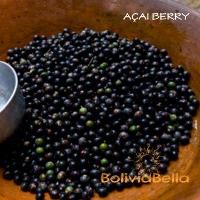Of course Bolivian fruit includes many of the common fruits found elsewhere, but so many BoliviaBella readers have asked for information on more unusual, exotic varieties of fruit, I've dedicated this entire section just to fruit, especially tropical fruits found in Eastern Bolivia.
This does not mean these fruits are native only to Bolivia or that they grow only in Bolivia. Just that they are grown and consumed here.
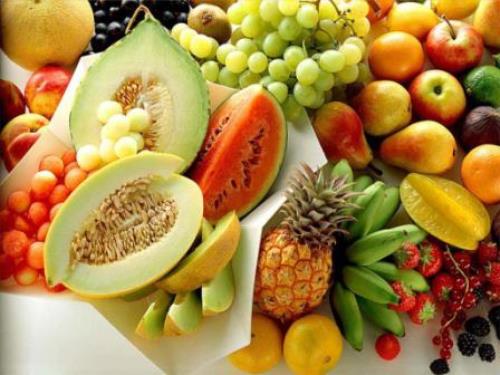
To provide you the following photos and information I actually went to the market, bought a bunch of Bolivian fruit and took photos of it. I’ll be on a fruit diet for a week.
Other fruit you can find in Bolivia as commonly as anywhere else: apples, oranges, lemons, limes, grapefruit, tangerines, peaches, nectarines, apricots, green grapes, purple grapes, red grapes, strawberries, raspberries, pineapple, figs, dates, plums, canteloupe, watermelon, honeydew melon, pears, kiwi, mangoes, and many more.
AÇAI BERRY The açai berry is so interesting it has its own section. It has antioxidants in amounts never before heard of in fruit. It's very healthy and has many vitamins and minerals. Because of this, it's become very famous all over the world and people claim it can do all kinds of things from helping you to lose weight to curing cancer. By the way, the letter "ç" in "açai" is pronounced like an "s". Say "aw-saw-ee".
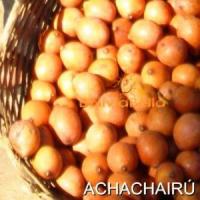
ACHACHAIRÚ
This small orange, semi-acidic fruit is native to the tropics of Bolivia and one of my favorites! The achachairu's scientific name is Garcinia sp. (or Bolivian mangosteen). Some foreigners call it the purple mangosteen and I have no idea why, since it's actually orange on the outside and white on the inside with brown seeds. Nothing purple about it. The Achachairú Festival takes place every January!
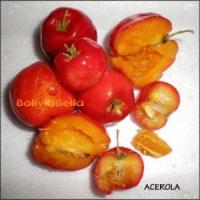
ACEROLA
Acerola is a very small Bolivian fruit also common in Brazil, about the size of a cranberry. It is soft inside and rather acidic. It has 3 or more large strangely-shaped seeds. You can't really it eat it as is - it's best blended, then strained for juice.
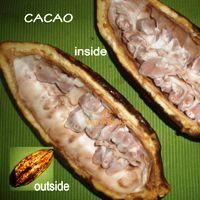
CACAO
This rather ugly looking fruit is one of the most loved fruits in the world! Not because the fruit itself is very delicious (most people don't eat the pulp) but because this is what chocolate is made from! Cacao pods have large dark seeds inside which are covered in a slimy mucous (which some people boil and cool, then strain to make juice). The seeds are then dried and toasted. Once toasted, they are ground or smashed into a really fine powder - cocoa powder!
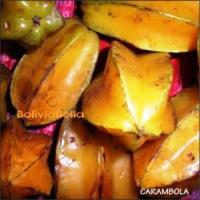
CARAMBOLA
Carambola is known in English as "star fruit" due to its shape. This is personally one of my favorite Bolivian fruits. It has a very mild flavor raw, but blended and strained it becomes a fabulous, slightly acidic juice. People with renal failure can NOT have it!!
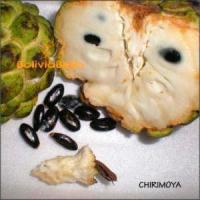
CHIRIMOYA
I've seen chirimoya spelled with an "e" quite often in English. You can sometimes find it in U.S. grocery stores. It's tough exterior belies the extremely soft and creamy interior you encounter when you cut it open. Chirimoya is sweet and delicious and is commonly used to make ice cream in Bolivia. If the flesh inside is brown, it's too ripe.
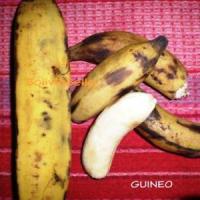
GUINEO
You're probably asking yourself what's so special about a banana. This banana differs from the common banana in that it is very very small. It also tends to be extremely sweet. These are the best bananas for banana bread! In Ecuador they are called "oritos" (little golden ones). In Bolivia we call them guineos. Notice the small size!
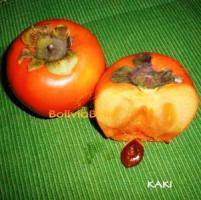
KAKI
This tomato look-alike is actually a sweet fleshy fruit called a kaki in Bolivia, but is available in many parts of the world and is known in English as a persimmon. Great for eating raw (sans the rather thick tasteless skin). Lousy blended or as a juice.
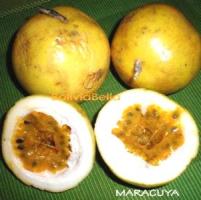
MARACUYÁ
Maracuyá is an extremely acidic fruit. It's thick outer skin shelters numerous black seeds inside which are covered in a thick mucous-like membrane. You can't really eat it raw at all, it's disgustingly acidic. However if you blend it, strain it and add some sugar it's one of the most delicious (and refreshing) juices you can make! One reader wrote in: when fully ripe the skin is dry and brittle and you can suck up the inside of the fruit and it's sweet. Thanks for that Francisco!
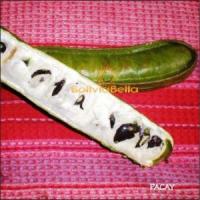
PACAY
Pacay is really unusual. This Bolivian fruit grows in a pod like beans, but these hang from trees. The shell is very hard and usually has to be cracked or cut open with a knife. Inside you'll find several large, black seeds all lined up in a row. Each is covered in a white fuzzy skin that feels like velvet. Pop out each seed individually, put it in your mouth, suck off the sweet, white membrane and spit out the seed. Pacay can be just a few inches long, or several feet long!
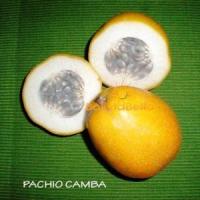
PACHIO
Pachio camba is related to the pomegranate. It has a tough outer shell that must be cracked or cut open. Inside, like the maracuya, are many little black seeds covered in what looks like mucous (get that image out of your head - it's delicious). However, unlike the maracuya, this fruit is sweet, not acidic. Using a spoon you scoop out the seeds and membrane and eat them. Don't bother chewing. Just enjoy the sweet bugger-like consistency for a while, then swallow.
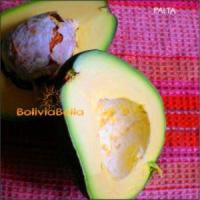
PALTA
Palta is what Bolivians call an avocado (or aguacate, if you're from Mexico). Avocado trees grow up to 4 stories high and a great number of avocados grow near the top of the tree so getting them down is no easy feat. However, they're worth a climb if you can find a three-pounder like the huge one pictured here. This Bolivian fruit is best when it has no black spots on its skin and the inside is about the consistency of butter. Normally people eat them in salads and most consider them a vegetable because they are green, but they are actually a fruit.
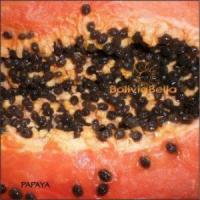
PAPAYA
Papayas are becoming pretty common in many parts of the world and there are several varieties. Blended papaya slathered onto your hair does wonders as a conditioner. Mostly, we eat papaya raw in fruit salad here in Bolivia, and blend it and pour it over meat because it's a wonderful natural meat tenderizer. Papayas can be tiny or very large (up to 5-6 pounds). Look for one that is more yellow/orange than green on the outside and hopefully you'll get one with a perfect interior like the one pictured here. This is THE color your papaya should be for optimal sweet goodness.
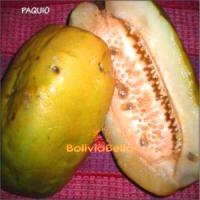
PAQUIÓ
Paquio, a Bolivian fruit more commonly known as pachio, looks exactly like a papaya on the outside, and except for being whitish, looks similar to one on the inside too! However, it is actually related to the passion fruit and grenadine (like the maracuya and pachio camba) and it's inside has small seeds covered in a mucousy membrane too. Unlike the maracuya and pachio camba, we more commonly eat the flesh, not the seeds. This fruit has such a mild flavor, it's not good as a juice at all.
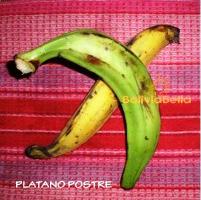
PLATANO
These are plantains. In Bolivia we call the common table banana you can find everywhere a "platano". Therefore, so as to not cause any confusion, we call the plantain a "platano postre" (dessert banana) although we usually eat it as a side with our main meals. Plantains when green are not sweet at all and are hard. These are good cut and fried and salted (most commonly used to make banana chips too). Once they've ripened and become yellow, the plantain is very sweet!
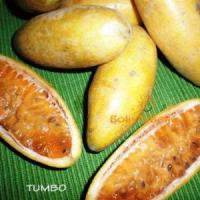
TUMBO
The tumbo, related to the maracuya, is extremely sour and acidic inside. You cannot usually eat this fruit raw. As with the maracuya, you scoop out the mucousy seeds, blend them with water and sugar, strain it and you've got an incredibly DELICIOUS juice! Because it is acidic, like lemonade it is very refreshing when it's hot outside.
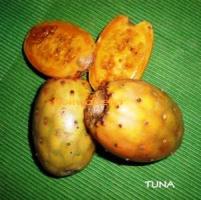
TUNA
This Bolivian fruit is called tuna. It's actually cactus fruit (in the U.S. people call it a prickly pear). Inside it has many tiny super hard seeds. Deal with it. There are too many to pick them out. The flesh surrounding them is sweet and has a mild very nice flavor. You don't eat the skin. So as not to confuse you, a small Spanish lesson: in Spanish tuna is cactus fruit. TUNAFISH is atún (pronounced uh-TOON!) Bless you.
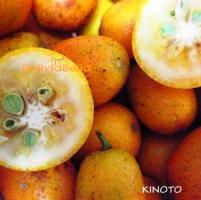
KINOTO
This little citrus fruit is called a Kinoto. I say little, because they are truly tiny - only about an inch long each! They aren't very good to eat raw, but bakers grate their peelings to flavor foods and if you blend and strain them, you get a really really mild citrus (orangy flavored) juice. They aren't very juicy - kind of dry inside.
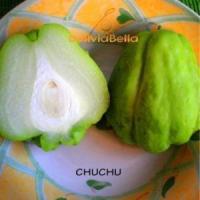
CHUCHU
This strange-looking fruit is called a Chuchu (choo-choo) in Bolivia. It is shaped sort of like a pear and its texture is hard like that of a green apple. I'm not sure what people use if for - it has absolutely no flavor at all - I tried one and the flavor was similar to biting into a piece of plastic, quite literally. I'm researching but so far, no one else seems to know what they're used for either - although you find them at the grocery stores all the time when they are in season.
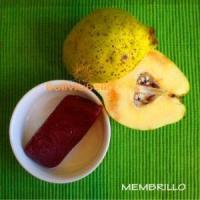
MEMBRILLO
This is a Membrillo. In English it's known as "quince". It has the texture of a hard apple and if you sniff it, it smells exactly like a green apple too. You can't really eat it because it's rather tasteless; however, in Bolivia it is used to make a really thick jam called "dulce de membrillo" that is so thick they sell it in blocks and you have to cut it to spread it on your bread (pictured above). It is one of the most delicious jams in the world and the flavor is absolutely unique!
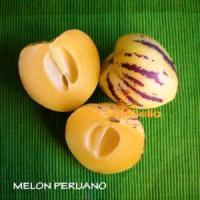
MELÓN PERUANO
This very mild-flavored fruit is part of the melon family, and is called Melón Peruano "Peruvian melon" in Bolivia because it is often imported from Peru. Although it is very small (about the size of an apple) and the it's peeling is very thin (you can eat the peeling if you like) the flavor and texture are almost exactly like that of a honeydew melon. It's great in fruit salad.
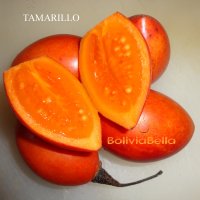
TAMARILLO
The tamarillo is known in other countries as the tree tomato. It's not really a tomato at all. The tamarillo is native to the Andes mountain region of Peru, Chile, Ecuador, Colombia and Bolivia, although it can also be grown in the tropical lowlands. The tamarillo's color ranges from yellow or orange to dark red or even purple (the lighter the color, the sweeter the fruit). The pulp is sweet but the peeling, which is paper thin, is bitter. The tamarillo has a delicious pungent fruity but tangy smell similar to the mango and is delicious in marmalade, juice, desserts, or fresh.

